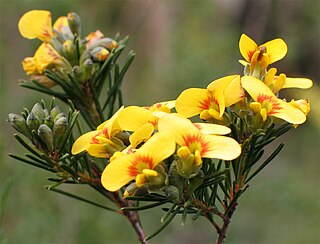Marsh phlox may refer to several species in the genus Phlox :
- Phlox glaberrima , also called smooth phlox
- Especially Phlox glaberrima subsp. interior, the Wabash smooth phlox
- Phlox maculata , also called meadow phlox
- Phlox kelseyi , Kelsey's phlox
Marsh phlox may refer to several species in the genus Phlox :

Phlox is a genus of 68 species of perennial and annual plants in the family Polemoniaceae. They are found mostly in North America in diverse habitats from alpine tundra to open woodland and prairie. Some flower in spring, others in summer and fall. Flowers may be pale blue, violet, pink, bright red, or white. Many are fragrant.
Creeping phlox is a common name for several plants and may refer to:
Flowering moss is a common name for several plants and may refer to:
Service tree can refer to:
Moss phlox is a common name for several plants and may refer to:
Woodland phlox is a common name for several plants and may refer to:

Dillwynia glaberrima commonly known as the smooth parrot-pea, is a flowering plant in the family Fabaceae. It is a small upright shrub with liner leaves and clusters of yellow flowers.
Lasthenia glaberrima is a species of flowering plant in the family Asteraceae known by the common names smooth goldfields and rayless goldfields. It is native to western North America from British Columbia to California, where it grows in wet meadows and vernal pools.
P. nivalis may refer to:

Oryza glaberrima, commonly known as African rice, is one of the two domesticated rice species. It was first domesticated and grown in West Africa around 3,000 years ago. In agriculture, it has largely been replaced by higher-yielding Asian rice, and the number of varieties grown is declining. It still persists, making up an estimated 20% of rice grown in West Africa. It is now rarely sold in West African markets, having been replaced by Asian strains.
Hairy phlox is a common name for several plants and may refer to:
P. gracilis may refer to:

Torminalis is a genus of plants in the rose family Rosaceae. The genus Torminalis was formerly included within the genus Sorbus, as the section Torminaria, but the simple-leafed species traditionally classified in Sorbus are now considered to form a separate monophyletic group. It is monotypic, being represented by the single species, Torminalis glaberrima, commonly known as wild service tree, chequers, and checker tree. This tree is native to Europe, parts of northern Africa and western Asia.

Phlox glaberrima, commonly called smooth phlox and sometimes marsh phlox, is a species of flowering plant in the phlox family. It is native to the Midwestern and Southeastern United States where it is found in moist to wet areas. It can be found in both prairies and forests, where it is an indicator of high quality habitat.
Mountain phlox is a common name for several plants and may refer to:

Phlox maculata, commonly called meadow phlox, as well as wild sweet William and marsh phlox, is a species of flowering plant in the family Polemoniaceae, native the eastern United States and introduced to eastern Canada. It is a perennial.

Leiopathes is a genus of hexacorallians belonging to the anthozoan clade Antipatharia. It is the only genus in the Leiopathidae family. The genus name means "smooth disease".
Astilbe glaberrima, called the florist's spiraea and smooth rock astilbe, is a species of flowering plant in the genus Astilbe, native to Yakushima Island, Japan. Some authorities have it as a subspecies of Astilbe japonica, Astilbe japonica subsp. glaberrima. Its dwarf variety Astilbe glaberrima var. saxatilis has gained the Royal Horticultural Society's Award of Garden Merit.
Holothuria (Selenkothuria) glaberrima, also known as the brown rock sea cucumber, is a species of sea cucumber in the genus Holothuria, subgenus Selenkothuria. The cucumber is distributed in the Western Atlantic Ocean, the Caribbean Sea, and the Gulf of Mexico. The species is found at a depth of 0–42 meters.
Wild sweet William may refer to: